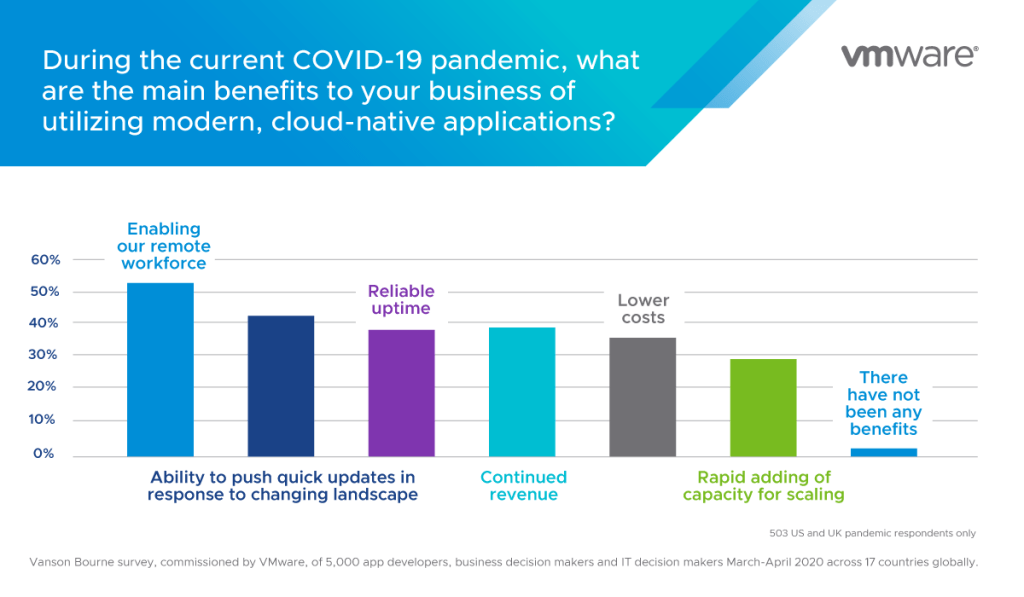A one-of-a-kind global survey—conducted before and during widespread shelter-in-place orders—reveals that despite popular belief, digital transformation isn’t failing. In fact, only 2% of respondents said their digital transformation efforts weren’t successful in any way.
In response to the 2020 global pandemic, organizations across the world rose to the occasion. They rapidly transitioned operations and spun up modern, cloud-native apps to keep their businesses running—and provide much-needed support for employees and customers.
Technology market research firm Vanson Bourne, commissioned by VMware, surveyed 5,000 app developers (app devs), business decision makers (BDMs) and IT decision makers (ITDMs) from March-April 2020 across 17 countries globally.
The survey showed that successful digital transformation is only possible if businesses embrace a holistic approach across three key organizational pillars: people, process and technology.
Successful Digital Transformation: Apps at the Ready
5 Key Findings from the Global Vanson Bourne Survey
From a shift in mindsets to a blueprint for digital transformation success, here are the top trends revealed by the survey.





Our digital transformation efforts so far made it possible to move workloads at will to find the most economical and efficient place to run them. Our next priority is utilizing the cloud to be more flexible when unexpected events happen.
PATRICK MCGRAW, SENIOR SYSTEMS ENGINEER, WESTERN CAROLINA UNIVERSITY
Contributors to Digital Transformation Success—Big or Small

Digital transformation certainly hasn’t been easy sailing for most organizations. In fact, almost 9-out-of-10 respondents admitted that at least one challenge hindered their progress. The more common challenges relate to processes and technology—two of the three key pillars of any digital transformation effort. Two stand out, in particular:
- Security is, of course, a crucial aspect of any technology-based change. Yet, there are often many technological, operational and organizational hurdles, which can make getting to intrinsic, or built-in, security feel like an uphill battle.
- Throughout the digital transformation process, companies tend to amass more and more technology platforms. Often, these platforms do not work together, which makes integrating new apps and software into the existing technology stack increasingly difficult.
The third pillar of successful digital transformation initiatives is people. The survey results show organizations that don’t put the right people in the right places are hamstrung before the change gets underway.
All three pillars—people, processes and technology—must be working in harmony for the initiative to meet all of its objectives and have a positive impact.


Our main digital transformation priority is to provide all internal users with a safe, secure and convenient way to perform their daily requirements, while minimizing additions to CapEx and OpEx.
TRAVIS ROBERTSON, INFORMATION TECHNOLOGY MANAGER, TOPPAN INTERAMERICA, INC.
Building a Cutting-Edge Culture
Today, technology is a business imperative. It was already a fundamental, integral part of organizational communications and workflows, but now the business culture–technology relationship has intensified because of the crisis.
MARIBEL LOPEZ, TECHNOLOGY INDUSTRY ANALYST AND STRATEGIC ADVISOR
The importance of people to digital transformation efforts is further cemented by an overwhelming majority of respondents agreeing that organizations with software-minded leaders are more successful. They also agree that digital transformation success is dependent on having people with varied technical skills involved in the efforts.
With the business landscape changing so rapidly, someone with an agile mindset, such as an app developer, might be best suited to lead future initiatives.
Modern Apps Power Digital Transformation
The most urgent priority is to update our applications, and we’re opting for a cloud-native, cloud-first strategy. Early efforts have already helped us improve speed to market.
STEVE LESTER, SENIOR TECHNICIAN, COOP

Without the unique benefits of cloud-native apps, many organizations could have found themselves in a much more precarious situation during the COVID-19 pandemic.
A great way to incorporate more speed and agility into the app/software development process is an autonomous self-service model for developers. As highlighted by app devs and ITDMs from high-performing organizations+, some of the benefits link directly to the human experience for both end users and employees. This model also provides greater efficiency and gets more projects to production faster.
Yet again, the survey findings identify the fundamental links between people and processes. And with app dev and ITDM respondents from high-performing organizations showing a greater understanding of the benefits, it is easy to see why they’re ahead of underperforming counterparts.
The Debate Is Over
The world recently experienced an unprecedented and nearly total shift to digital channels, communications and business models.
Industries with no digital touchpoints had to quickly launch apps to ensure continuity. And many cloud-native businesses are now dealing with an order of magnitude more traffic, revealing weak seams in their app architecture and ability to scale.
To achieve their digital transformation goals in our post-pandemic world, organizations must focus on the three key pillars—people, process and technology. And by shifting mindsets, enabling agile processes and embracing cloud-native technologies, organizations can power future-ready business.

